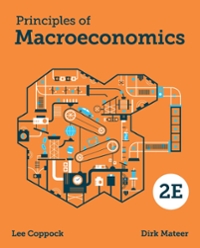Question
11.1 Use a diagram to illustrate an economy at the equilibrium inflation rate. In this diagram, show how a permanent increase in exports would affect
11.1 Use a diagram to illustrate an economy at the equilibrium inflation rate. In this diagram, show how a permanent increase in exports would affect the equilibrium inflation rate and the equilibrium level of GDP if the central bank did not react and change its monetary policy.
11.2 Suppose the central bank reacted to defend its inflation target from the effect of the increase in exports in Exercise 11.1. Use an AD/AS diagram to show the change in the equilibrium interest rate setting and real GDP you would observe.
11.3 Suppose opportunities for investing in high tech applications boost aggregate demand in the short run, and aggregate supply in the long run. Using AS and AD curves with equilibrium at potential output, show why output might rise in the long run without much of an increase in inflation.
11.4 Suppose a new round of labour negotiations results in a higher average rate of increase in money wage rates for the next three years. Illustrate and explain how this would affect short-run aggregate supply conditions and the AS curve.
11.5 Draw an aggregate supply and demand curve diagram to show an economy in shortrun equilibrium at potential output. Suppose a wide-spread recession reduces incomes in foreign countries, leading to reduced demand for exports. Illustrate and explain how this would affect the short-run equilibrium Y and in your diagram.
11.6 Suppose central banks have reduced their policy interest rates to the lower bound to fight a deep and prolonged recession. Use a diagram to show how either a reduction in the inflation rate, or deflation, would change the slope of the AD curve. Would cuts in nominal money wage rates and further reductions in the inflation rate reduce the recessionary gap when the central bank is constrained by the lower bound on its interest rate?
11.7 In the two years before 2008 the Canadian federal government reduced the GST from 7 percent to 5 percent. Use an AD/AS/YP diagram to illustrate and explain the effects of this tax change on equilibrium output and inflation. If the economy was in equilibrium at YP and the target inflation rate before the tax cut, what monetary policy action, if any, would the central bank make to maintain those equilibrium conditions after the tax cut? What short-run net benefit, if any, would households and businesses realize as a result of the cut in the GST?
11.8 Define the 'public debt' and explain why and how it might increase from one year to the next. 302 Inflation, real GDP, monetary policy & fiscal policy Exercise 11.9 Would it be possible for the ratio of the public debt to GDP (PD/Y) to fall even if the government's primary budget is in deficit? Explain your answer.
11.10 Would it be possible for the ratio of public debt to GDP (PD/Y) to rise even if the government's primary budget balance is in surplus? Explain your answer.r
Step by Step Solution
There are 3 Steps involved in it
Step: 1

Get Instant Access to Expert-Tailored Solutions
See step-by-step solutions with expert insights and AI powered tools for academic success
Step: 2

Step: 3

Ace Your Homework with AI
Get the answers you need in no time with our AI-driven, step-by-step assistance
Get Started


